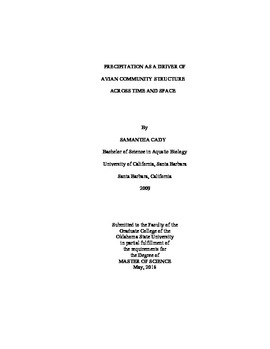| dc.contributor.advisor | O'Connell, Timothy J. | |
| dc.contributor.author | Cady, Samantha | |
| dc.date.accessioned | 2019-03-29T15:39:55Z | |
| dc.date.available | 2019-03-29T15:39:55Z | |
| dc.date.issued | 2018-05-01 | |
| dc.identifier.uri | https://hdl.handle.net/11244/317809 | |
| dc.description.abstract | Moisture variability can be a major driver of avian community structure across space by limiting species range edges, and over time by forcing individual movements or temporary species distributional shifts. This study examines (1) how temporal moisture variability changes patterns of species occurrence by assessing the impact of drought on birds in the Great Plains and (2) how spatial moisture variability structures avian communities across a longitudinal precipitation gradient in Oklahoma. Dickcissel showed a greater within-range colonization probability during drought (p < 0.001) indicating that, in addition to a northward distribution shift already known of the species, dickcissel also seek out previously unoccupied areas within the southern/core portion of their range during drought conditions. Different bird species responded to drought assessed at different temporal extents, with most birds showing the strongest signal at an annual or near-annual scale. However, the direction of effect was the same across all drought-responsive species, such that an increased drought intensity at any scale was always associated with decreased bird occupancy. Because drought quantified at multiple temporal extents relates to different hydrologic attributes (for example, drought examined at an annual extent correlates with groundwater availability while drought quantified at a monthly extent relates to precipitation anomalies and soil moisture), considering temporal scale while analyzing drought impacts may begin to reveal the mechanisms behind those impacts. This may provide a broader understanding of the effects of global climate change on species and the landscapes they inhabit. In the Cross Timbers, avian communities had disproportionally higher species richness in riparian areas relative to the surrounding upland areas, a pattern which was not observed in the, comparatively more mesic, Ozark Plateau (i.e., richness was similar between riparian and surrounding upland areas in this region). This suggests high relative conservation importance of riparian areas in a more xeric environment, where riparian corridors represent ribbons of suitable habitat that highly contrast the surrounding landscape, which are crucial for supporting particular forest-dependent species and thus landscape-level biodiversity. | |
| dc.format | application/pdf | |
| dc.language | en_US | |
| dc.rights | Copyright is held by the author who has granted the Oklahoma State University Library the non-exclusive right to share this material in its institutional repository. Contact Digital Library Services at lib-dls@okstate.edu or 405-744-9161 for the permission policy on the use, reproduction or distribution of this material. | |
| dc.title | Precipitation as a Driver of Avian Community Structure Across Space and Time | |
| dc.contributor.committeeMember | Davis, Craig A. | |
| dc.contributor.committeeMember | Loss, Scott R. | |
| osu.filename | Cady_okstate_0664M_15749.pdf | |
| osu.accesstype | Open Access | |
| dc.description.department | Natural Resource Ecology and Management | |
| dc.type.genre | Thesis | |
| dc.type.material | text | |
